Inside The New York Botanical Garden
Sonia Uyterhoeven
Posted in Gardening Tips on September 2 2008, by Sonia Uyterhoeven
Extending Your Harvest
 Sonia Uyterhoeven is Gardener for Public Education at The New York Botanical Garden.
Sonia Uyterhoeven is Gardener for Public Education at The New York Botanical Garden.
 As September rolls in your tomatoes will start looking tired and your summer squashes will be looking the worse for wear. While it is time to pull some things out, the season is far from over. Extending your harvest is fairly simple.
As September rolls in your tomatoes will start looking tired and your summer squashes will be looking the worse for wear. While it is time to pull some things out, the season is far from over. Extending your harvest is fairly simple.
Timing is important. Read the seed packet for the days to maturity and count backward from the first frost date in your area. Remember that the fall is cooler so everything grows more slowly. Your vegetables will be smaller—but small also means tender.
What are some good candidates for planting? Loose-leaf lettuces are ideal for a fall sowing. They love the cool weather and are a fast-growing crop. Wait until the middle or end of August and start sowing them in the garden.
Turnips and beets make superb late-season crops. They are tender when young. Young beet greens are delicious in a salad or steamed.
“Cole crops” (cabbage, kale, kohlrabi, and broccoli) can withstand a light frost. They grow well in the fall and can be planted as a second crop either from seed or transplant in mid-July to late August. By the time these vegetables are maturing, it is nice and cool.
Summer squash and bush beans are prolific. With a single sowing they easily exhaust themselves by mid-summer, so why not try growing more in two separate sowings? Plant a second crop in mid- to late-July for a late-season treat.
Posted in Gardening Tips on August 25 2008, by Sonia Uyterhoeven
Cunning Caryopteris
 Sonia Uyterhoeven is Gardener for Public Education at The New York Botanical Garden.
Sonia Uyterhoeven is Gardener for Public Education at The New York Botanical Garden.
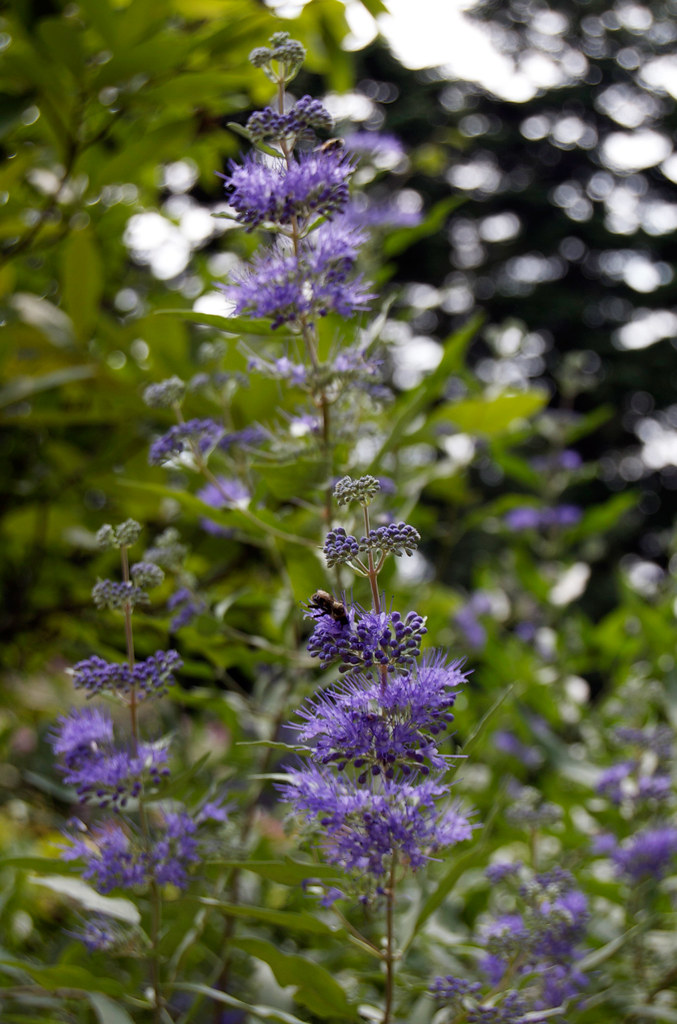 High on my agenda these days is using plants that benefit the environment while also doing the work I need a good plant to do, which is to create a beautiful garden. Caryopteris or blue beard fits this criterion.
High on my agenda these days is using plants that benefit the environment while also doing the work I need a good plant to do, which is to create a beautiful garden. Caryopteris or blue beard fits this criterion.
It is not a particularly needy plant; it doesn’t require copious amounts of fertilizer or water—in fact it likes good drainage and moderate to lean soil.
Caryopteris is a magnet for wildlife: Bees and butterflies cover the flowers while deer show no interest and leave it intact.
Finally, a bonus for the shrub world—it flowers in August, long after most woody plants have finished flowering for the season.
It has a nice open structure that makes it an adaptable companion in any mixed border. In one location we have it snuggling up to a Daphne ‘Carol Mackie’. The graceful blue beard’s loose branches would also spill nicely into any small- to medium-size ornamental grass, making the two a lovely late-season pair.
I cut this shrub back to a one- to two-foot framework in mid-April to keep it flowering freely and to maintain a compact three-to-four-foot fountain of pale-blue to deep-purple flowers for a late season display.
Posted in Gardening Tips on August 18 2008, by Sonia Uyterhoeven
Pondering Powdery Mildew
 Sonia Uyterhoeven is Gardener for Public Education at The New York Botanical Garden.
Sonia Uyterhoeven is Gardener for Public Education at The New York Botanical Garden.
Gardening is about observation. I have noticed over the past several years that my phlox and peonies that are out in full sun never suffer from powdery mildew while those that are in partial shade suffer miserably. What then are the lessons for the gardener?
Powdery mildew tends to create a problem for gardeners in middle to late summer. Unlike many fungal problems that need good moisture to take hold, powdery mildew thrives with warmth (temperatures around 70s-80s) and high humidity.
What can we do to alleviate the problem? Not surprisingly, good maintenance practices and smart gardening is the key to healthy plants.
- Do not overcrowd your plants; this will lead to poor air circulation and will create problems with the humidity level around susceptible plants.
- During the winter the fungus survives on plant debris, so it is important to clean up around infected plants.
- Using high nitrogen fertilizers (the first number on fertilizers) promotes weak, leafy growth; try a balanced fertilizer with low numbers and apply only once in the spring to give perennials a boost for the season.
- Choose disease-resistant cultivars whenever possible.
- Follow the maximum “the right plant for the right place.” A healthy plant is always more resistant to disease problems.
If your favorite perennials do get attacked with powdery mildew, you have several options. When powdery mildew attacks my peonies late in the season, I just cut them back once the leaves get unsightly. If your bee balm has succumbed and is beyond repair, then cut the foliage back; you will get a new flush of foliage but no more flowers for the rest of the season. If it is a late-season bloomer that you’re set on keeping, then remove the worst stems and apply an environmentally friendly product to the rest of the plant as soon as you notice the powdery mildew. Some options include products that contain neem oil, sulfur, or potassium bicarbonate.
Posted in Gardening Tips on August 11 2008, by Sonia Uyterhoeven
Well-behaved Waterlilies
 Sonia Uyterhoeven is Gardener for Public Education at The New York Botanical Garden.
Sonia Uyterhoeven is Gardener for Public Education at The New York Botanical Garden.
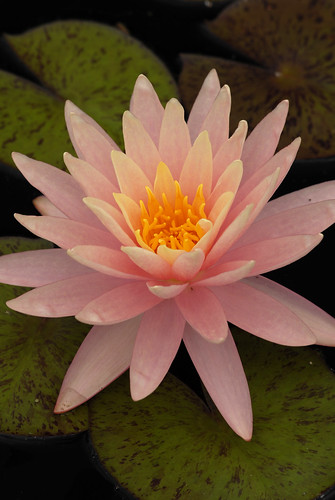 Waterlilies come in all sizes; it is important to find one that suits your location. Waterlilies that are appropriate for a tub garden should be up to 3 feet in diameter; a good size for a small pool is 4 to 6 feet in diameter.
Waterlilies come in all sizes; it is important to find one that suits your location. Waterlilies that are appropriate for a tub garden should be up to 3 feet in diameter; a good size for a small pool is 4 to 6 feet in diameter.
One popular small-sized waterlily for those of us living in Zone 6 is Nymphaea ‘Pygmaea Helvola’. It is a free-flowering waterlily that is well-suited for small ponds and containers, with mottled purplish leaves and bright semi-double yellow flowers. If red is your color, the 3-4 feet Nymphaea ‘James Brydon’ is good for a small pond. Prefer pink? Then you might be looking for Nymphaea ‘Joanne Pring’. Nymphaea ‘Chrysantha’, ‘Colorado’ and ‘Josephine’ are a few more small ones that you will find in our pools in the Enid A. Haupt Conservatory Courtyards.
Plant your waterlilies in an aquatic container (lined with burlap if needed) or a plastic pot. Use top soil to pot them up (potting soils are too light and should be avoided). Cover the container with pebbles or pea gravel and fertilize once a month with aquiform tablets that are pressed into the soil (waterlilies are heavy feeders). Initially, elevate the pot with bricks so that the young plant gets enough light. Six hours of sunlight will keep it blooming prolifically.
Posted in Gardening Tips on August 4 2008, by Sonia Uyterhoeven
The Cutting Garden
 Sonia Uyterhoeven is Gardener for Public Education at The New York Botanical Garden.
Sonia Uyterhoeven is Gardener for Public Education at The New York Botanical Garden.
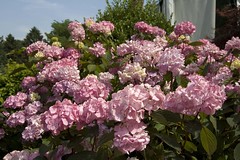
Cut flowers can transform your home in the summer, and many flowers are easy to grow in the garden. When designing your garden, plan for flowering shrubs such as lilacs, hydrangeas, and viburnums; grasses; and foliage plants such as hostas, Rex Begonias, and ferns.
The basic rules of thumb for cutting flowers from the garden are as follows:
- Cut early in the morning when the stems are nice and turgid; as the day heats up they start to dehydrate.
- Use sharp tools that will make a clean cut.
- Cut an inch from the bottom of the stem at a 45-degree angle, providing more surface area.
- Place the cuttings in a bucket of water immediately, otherwise the stems will seal up and inhibit absorption.
- Remove all foliage that is under water to prevent decay and bacterial growth, which shortens the flower’s vase life.
- Use lukewarm water unless you are arranging early season bulbs, which prefer cool water.
- Use flower food to increase the longevity of the arrangement. For a homemade version, mix together 1 teaspoon each of sugar, household bleach, and lemon juice.
- For flowers that grow on individual stems such as zinnias, dahlias, and sunflowers cut when the flower is open.
- For flowers that have multiple buds, use stems with a few buds open and others starting to show color. Snapdragons, delphiniums, phlox, and lilacs are some examples.
Posted in Gardening Tips on July 28 2008, by Sonia Uyterhoeven
Lepidopterist Delight
 Sonia Uyterhoeven is Gardener for Public Education at The New York Botanical Garden.
Sonia Uyterhoeven is Gardener for Public Education at The New York Botanical Garden.
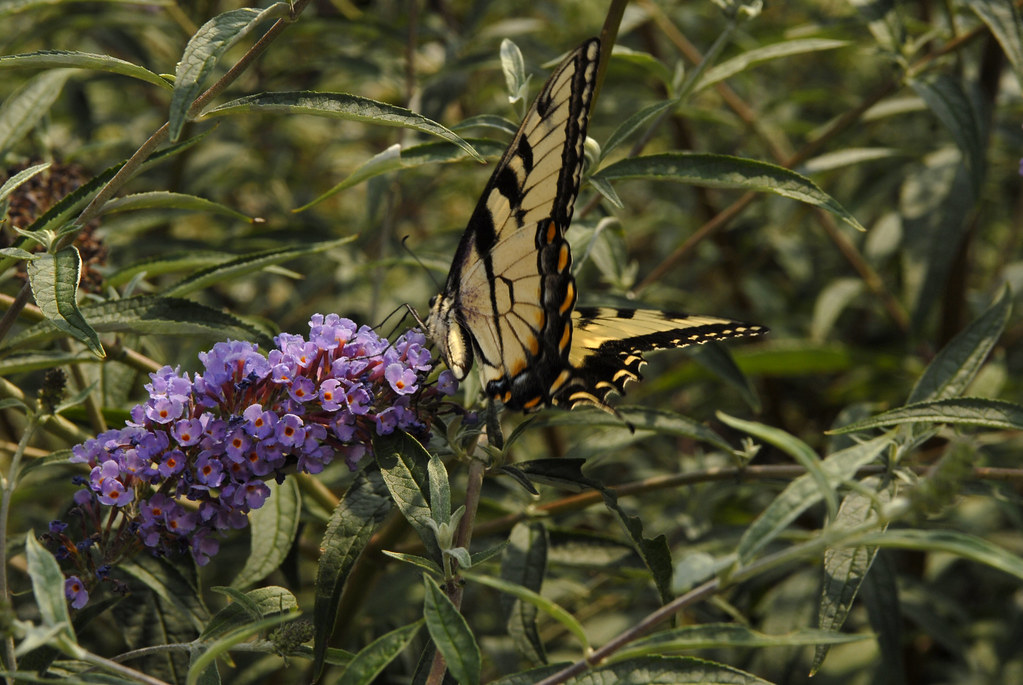 Butterflies delight us with a kaleidoscope of color. They are wonderful for educating children about nature, keeping us connected with the natural world, and giving us a deeper appreciation for insects in general.
Butterflies delight us with a kaleidoscope of color. They are wonderful for educating children about nature, keeping us connected with the natural world, and giving us a deeper appreciation for insects in general.
Butterflies are also second to bees are our most important plant pollinator. They are sensitive to the environment and so are good indicators of the health of the environment. How then can we encourage them into our garden?
Butterflies need sunny, open spots that are protected from heavy winds. They need a sunning area such as a rock, a path, or pavement, where they can sit and warm up (insects are cold blooded). Just like birds need a bird bath for water, butterflies need puddles or a pool of water where they can get moisture and minerals. The garden should be free of pesticides.
To draw butterflies into your yard, provide plants that are a good source of nectar such as butterfly bush, lilacs, lavender, bee balm, ornamental sage (salvia), cosmos, zinnias, coneflowers, and asters, to name a few.
Also remember to provide food sources for hungry caterpillars that will eventually be transformed—through metamorphosis—into the stately butterfly. Host plants include fennel, parsley, violets, blueberry bushes, dogwoods, viburnums, cherries, and maples.
Posted in Gardening Tips on July 21 2008, by Sonia Uyterhoeven
Heavenly Herbs
 Sonia Uyterhoeven is Gardener for Public Education at The New York Botanical Garden.
Sonia Uyterhoeven is Gardener for Public Education at The New York Botanical Garden.
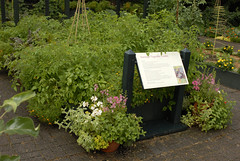 Herbs are easy to grow and are rewarding for the culinary-minded gardener. It is better to neglect your herbs rather than take too much care or to fuss over them. The most work you will need to do is pinching back herbs so that they don’t get leggy or go to flower.
Herbs are easy to grow and are rewarding for the culinary-minded gardener. It is better to neglect your herbs rather than take too much care or to fuss over them. The most work you will need to do is pinching back herbs so that they don’t get leggy or go to flower.
- Most herbs like full sun; the few exceptions that can handle part shade are parsley, mint, dill, and basil.
- Herbs like good drainage—if they are container-grown, normal potting soil will do.
- Herbs tend to be more fragrant when not fertilized and kept lean—basil is the exception.
- Basil, dill, and cilantro are easy to sow from seeds. Basil is not frost hardy and needs to be placed outside after the last frost date; cilantro on the other hand is a fast-growing, cool-season crop.
- Mints have a tendency to be invasive and are best used as either container plants or planted in a large pot that is sunk into the ground. This will provide an effective barrier for about 3 years.
Experiment with herbs in your garden and have fun. This year we have ‘Doone Valley’ thyme and silver thyme (Thymus vulgaris ‘Argenteus’) in the vegetable garden; they both have a wonderful citrus fragrance. Cuban oregano (Plectranthus amboinicus) is a newcomer to the vegetable garden this year with its pungent foliage. It can be used just like sage in cooking. Basil ‘Red Rubin’ retains its red color even as it ages and is a staple in the Home Gardening Center, but there are so many others to choose from such as the exotic Thai basil ‘Siam Queen’.
Posted in Gardening Tips on July 14 2008, by Sonia Uyterhoeven
A Fragrant Daylily
 Sonia Uyterhoeven is Gardener for Public Education at The New York Botanical Garden.
Sonia Uyterhoeven is Gardener for Public Education at The New York Botanical Garden.
 Daylilies are marvelous additions to the summer border. They are easy to grow and have large, trumpet-shaped blooms that scream out “Look at me!” Hybridizing daylilies is a passion of many, and the market is always flooded with a multitude of options. Some are short, some are tall, some have flowers the size of your hand. The latest trends are for re-blooming daylilies that flower from July into September. Rosy Returns is a popular performer, Apricot Sparkles is a peachy compact choice, the dark-eyed Moonlight Masquerade will woe you with the striking contrast of wine and cream, and Indian Giver will quickly find a way into your heart with its iridescent rose-pink flowers.
Daylilies are marvelous additions to the summer border. They are easy to grow and have large, trumpet-shaped blooms that scream out “Look at me!” Hybridizing daylilies is a passion of many, and the market is always flooded with a multitude of options. Some are short, some are tall, some have flowers the size of your hand. The latest trends are for re-blooming daylilies that flower from July into September. Rosy Returns is a popular performer, Apricot Sparkles is a peachy compact choice, the dark-eyed Moonlight Masquerade will woe you with the striking contrast of wine and cream, and Indian Giver will quickly find a way into your heart with its iridescent rose-pink flowers.
While longevity of bloom is always appealing, don’t overlook the fact that a number of daylilies have fragrance. My favorite is a pale lemon-yellow daylily named Hyperion. It has a happy home in the corner of my vegetable garden and is the main attraction in July. Often plants are described as being fragrant when they have a light scent—this one is truly fragrant. Other fragrant daylilies include Kathy Rood, Fragrant Light, Scape Stopper, and Vanilla Fluff.
Posted in Gardening Tips on July 8 2008, by Sonia Uyterhoeven
What’s at Stake?
 Sonia Uyterhoeven is Gardener for Public Education at The New York Botanical Garden.
Sonia Uyterhoeven is Gardener for Public Education at The New York Botanical Garden.
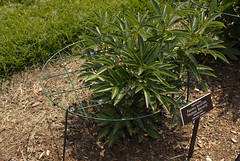
The best advice that I have ever heard about staking plants in the garden is twofold: Stake early before the plants need it, and don’t put your plants in a straight jacket—the idea is to see the plant and not the staking.
The aim then is to hide the stakes in the plant; when using string or twine pass it underneath the foliage and work with the natural structure of the plant. There are many different staking techniques and products available to the gardener.
You can use store-bought products such as peony hoops that fit neatly over the plant and can be raised up as the perennial grows. A plethora of stakes are available in gardening centers and from catalog companies; find the ones that work for you and your perennials.
For some jobs you can take the bounty of your spring pruning and use the branches as stakes. I have done this in the vegetable garden in the Home Gardening Center using leftover butterfly bush (Buddleia) branches to hold up peas and climbing nasturtiums. The key here is to place the twigs close to each other and get them deep enough into the ground so that they can support the plant.
Most of the staking done in this garden is done the old-fashioned way, with bamboo stakes and string. The stake generally needs to support only the bottom half of the perennial; in this way it doesn’t obstruct the view of the flower spike and lets the plant move naturally in the wind.
If the plant can only be viewed from one direction, stake from behind. If the plant can be viewed from all four sides, place the cane in the center of the plant. Drive the cane deeply into the ground to give maximum support. When tying the stems, work the strings beneath the foliage. Make a figure eight around the stem with the string and tie to the stake. If the plant has multiple stems, loop the string around all the main stems and tie to the stake.
Posted in Gardening Tips on July 1 2008, by Sonia Uyterhoeven
Slugging It Out
 Sonia Uyterhoeven is Gardener for Public Education at The New York Botanical Garden.
Sonia Uyterhoeven is Gardener for Public Education at The New York Botanical Garden.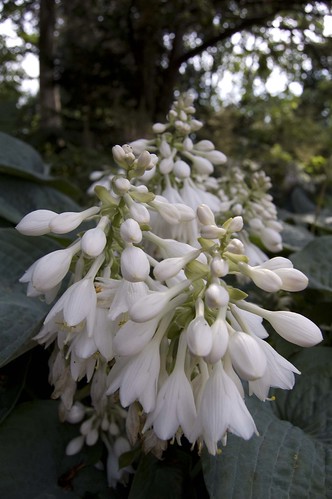
I love hostas. Since they are so overused they have the potential for being an exceptionally boring plant, yet they are saved by the fact that they excel in shade, are wonderful foliage plants, and come in so many different shades, textures, and sizes.
The only problem is that by midsummer they are full of holes. Hostas are a staple of the slug’s diet, so often a little extra care from the gardener is needed to keep them from an “unholy” state.
Commercial products that prevent slugs from devouring hostas contain iron phosphate and are safe and easy to use. There are also many home remedies. The classic one is to set out a bowl of beer, leading to the slugs drowning to their delight. Rumor has it that slugs will travel up to two miles for a good drink.
Another simple alternative is to surround your hostas with a small barrier of used coffee grounds: caffeine kills slugs. You can also surround your hostas with diatomaceous earth or trap them with grapefruit rinds (you are then left to clean up the mess). Hostas that have thick, puckered leaves are less susceptible to attack.
 Sonia Uyterhoeven is Gardener for Public Education at The New York Botanical Garden.
Sonia Uyterhoeven is Gardener for Public Education at The New York Botanical Garden. As September rolls in your tomatoes will start looking tired and your summer squashes will be looking the worse for wear. While it is time to pull some things out, the season is far from over. Extending your harvest is fairly simple.
As September rolls in your tomatoes will start looking tired and your summer squashes will be looking the worse for wear. While it is time to pull some things out, the season is far from over. Extending your harvest is fairly simple.







